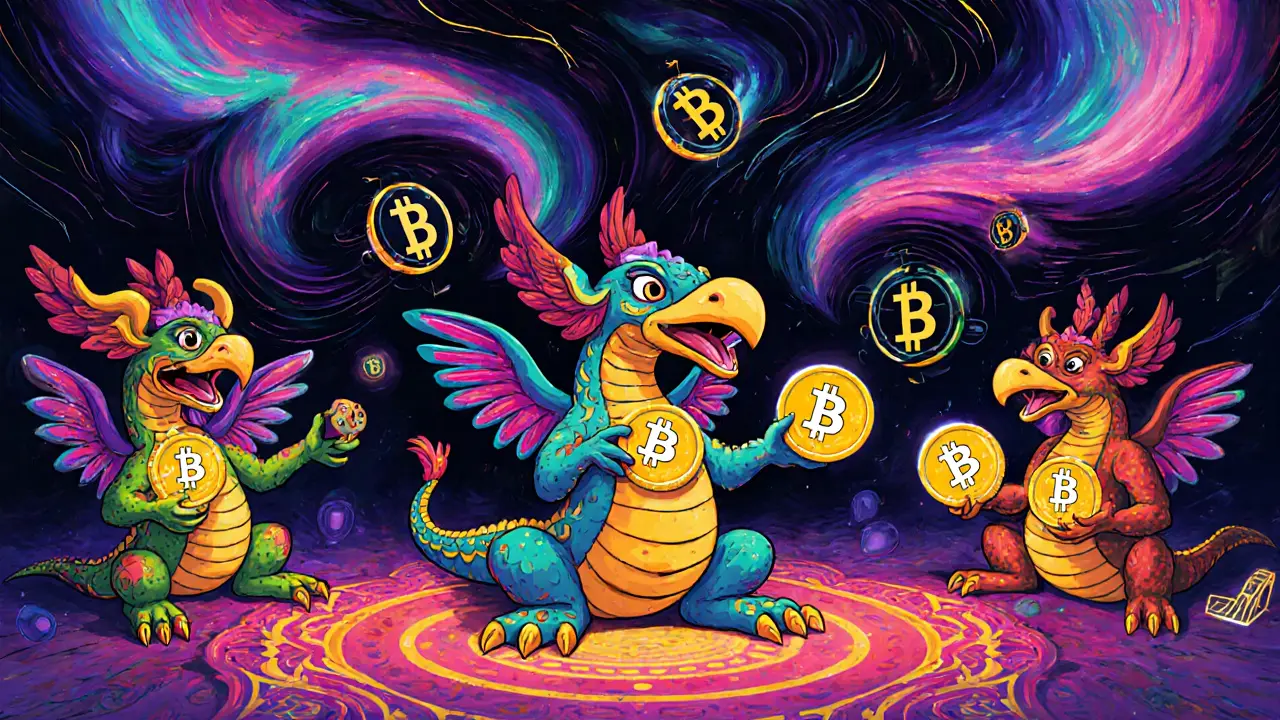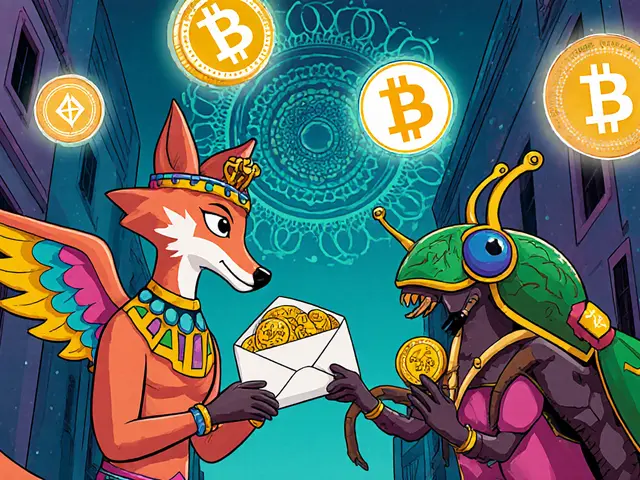KiloEx Leverage Calculator
Calculate Your Trading Risk
Understand how leverage impacts your position and liquidation risks on KiloEx. Input your investment, leverage level, and price movement to see potential outcomes.
Important Risk Warning: With 100x leverage, a 1% price movement can cause a 100% loss. KiloEx trading carries high risk. Never invest more than you can afford to lose.
Results
Position Size
$0.00
Liquidation Price
$0.00
Potential Outcome
$0.00
KiloEx (KILO) isn’t just another crypto coin. It’s the native token of a decentralized platform built for high-leverage trading-specifically perpetual futures. If you’ve ever tried trading Bitcoin or altcoins with 50x or 100x leverage on a decentralized exchange, you’ve probably heard of KiloEx. But what exactly does KILO do? And is it just another speculative token, or does it have real utility? KiloEx launched in 2023 as a DEX focused entirely on perpetual contracts. Unlike most decentralized exchanges that handle spot trading, KiloEx lets users trade derivatives-bets on price movements without owning the underlying asset. It supports Bitcoin, Ethereum, forex, commodities, and indices, all with leverage up to 100x. That’s significantly higher than competitors like GMX (30x max) or dYdX (50x max). For traders looking to amplify gains in volatile markets, that’s a big draw. The platform runs on opBNB and Base blockchains, not Ethereum. That’s intentional. Ethereum’s high gas fees and slow speeds made it tough for retail traders to use derivatives effectively. By moving to Layer 2 chains with low fees and fast confirmation times, KiloEx keeps trading smooth even during spikes in market activity. Trades execute on-chain, meaning no central authority holds your funds. You control your wallet, your positions, and your risk. The KILO token is the backbone of this system. Total supply is fixed at 1 billion tokens. As of November 2025, around 211.7 million KILO are in circulation. The token isn’t just a trading pair-it’s used for governance, staking, and fee discounts. Holders can vote on upgrades, fee structures, and new trading pairs. This makes KILO more than a speculative asset; it’s a governance tool. Here’s where it gets interesting: KiloEx uses a dual-token system. Alongside KILO, there’s xKILO. You get xKILO by locking up your KILO tokens in a staking contract. But here’s the catch: xKILO is non-transferable. You can’t sell it or trade it. It’s purely a reward token. In return for locking KILO, you earn a share of 70% of all trading fees generated on the platform. This creates a direct incentive for users to hold KILO long-term and contribute to platform liquidity. This model is unique. Most DeFi projects reward stakers with the same token they’re staking. KiloEx separates utility (KILO) from rewards (xKILO). The idea is to prevent dumping-holders can’t just cash out their rewards immediately. They’re locked into the ecosystem. Critics argue this creates artificial scarcity, but early data shows it’s working. Over 63% of KILO holders have kept their tokens for more than 90 days, according to CoinMarketCap’s sentiment data. But KiloEx isn’t without problems. Its Total Value Locked (TVL) sits at around $4.65 million as of November 2025. Compare that to GMX, which holds over $387 million. That’s a massive gap. Lower liquidity means wider spreads and higher slippage, especially on large trades. If you’re trying to open a $50,000 position, you might not get filled at the price you want. That’s a dealbreaker for serious traders. Trading volume is also low. KILO’s 24-hour volume hovers around $1.71 million. That’s less than 1% of dYdX’s volume. Most of the activity comes from retail traders in Southeast Asia and North America. Institutional players aren’t on the platform yet. Why? Because they need deep liquidity, fast execution, and institutional-grade APIs-all things KiloEx is still building. The platform’s roadmap includes cross-chain margining (expected in Q1 2024), an institutional API (Q2 2024), and options trading (Q4 2024). If those launch on time, KiloEx could attract more serious users. But execution matters. Many DeFi projects announce ambitious roadmaps and never deliver. User feedback is mixed. On Reddit, some traders praise the speed and low slippage during volatile moves. One user reported successfully executing a 50x BTC long during a flash crash with minimal price impact. Others complain about poor documentation and slow customer support. New users often get confused by the KILO/xKILO system. A CryptoSlate study found 43% of newcomers didn’t understand how the dual-token model worked. The platform has since added an interactive tutorial, but it’s still not enough. Price action tells another story. KILO hit an all-time high of $0.153 in March 2023. As of November 2025, it trades around $0.0139-down over 90%. That’s not unusual for DeFi tokens, but it does reflect the risks. Token distribution is also concentrated: the top 10 wallets hold 58.3% of circulating supply. That means a few large holders could influence the price significantly. Regulatory risk is real too. The U.S. CFTC has signaled it’s watching DeFi derivatives platforms closely. High-leverage trading is a red flag for regulators. If KiloEx ever tries to attract U.S. users, it could face legal pressure. For now, the platform avoids direct marketing in the U.S., but users still access it via VPNs. So who should use KiloEx? If you’re a retail trader comfortable with leverage, familiar with DeFi wallets like MetaMask, and okay with lower liquidity, KiloEx offers a rare chance to trade 100x leveraged assets without a centralized exchange. The tokenomics are clever, and the platform is technically sound. But if you’re looking for a stable investment, deep liquidity, or institutional-grade tools-you’ll be disappointed. KiloEx isn’t designed for that. It’s a niche tool for a specific kind of trader: bold, tech-savvy, and willing to accept high risk for high reward. The future of KILO depends on whether KiloEx can grow its liquidity without sacrificing its decentralized ethos. If it can, it might carve out a lasting space in the DeFi derivatives market. If not, it risks becoming another footnote in crypto history. If you’re considering KILO, start small. Learn the interface. Understand how leverage and liquidations work. And never invest more than you can afford to lose. This isn’t a get-rich-quick coin. It’s a high-stakes trading platform with a token attached.
How to Get Started with KiloEx (KILO)
Using KiloEx requires a few steps, but it’s not overly complex if you’ve used DeFi before. 1. Get a Web3 wallet-MetaMask, Trust Wallet, or Coinbase Wallet. Make sure it’s connected to the opBNB or Base network. 2. Buy KILO tokens-You can’t buy KILO directly on KiloEx. Use a centralized exchange like MEXC, Gate.io, or KuCoin to buy KILO with USDT or ETH, then send it to your wallet. 3. Connect your wallet-Go to kiloex.io and click ‘Connect Wallet.’ Select your wallet provider. 4. Deposit funds-Deposit USDT or other supported assets into KiloEx’s trading pool. You’ll use this to open positions. 5. Trade or stake-Choose a trading pair (BTC/USDT, ETH/USDT, etc.), set your leverage (up to 100x), and open a long or short. Or, go to the staking page to lock KILO and earn xKILO. 6. Track your positions-Use the real-time dashboard to monitor P&L, liquidation price, and margin level. The platform’s interface is clean, but the learning curve is steep. If you don’t understand how leverage works, you can lose your entire deposit in minutes. Watch tutorials. Read the docs. Practice on small amounts first.
How KILO Compares to Other DeFi Derivatives Platforms
Here’s how KiloEx stacks up against its closest competitors:
| Feature | KiloEx (KILO) | GMX | dYdX | Kwenta |
|---|---|---|---|---|
| Max Leverage | 100x | 30x | 50x | 20x |
| TVL (Nov 2025) | $4.65M | $387M | $1.2B | $150M |
| 24h Volume | $1.71M | $210M | $268M | $85M |
| Blockchains | opBNB, Base | Arbitrum | StarkEx (L2) | Arbitrum |
| Token Model | Transferable KILO + Non-transferable xKILO | Single GMX token | Single DYDX token | Single KWENTA token |
| Fee Distribution to LPs | 70% to xKILO stakers | 50% to GLP holders | 50% to DYDX stakers | 40% to stakers |
| Best For | High-leverage retail traders, token governance | High-volume traders, deep liquidity | Professional traders, institutional access | Simple trading, low fees |

Is KILO a Good Investment?
There’s no simple answer. KILO isn’t a store of value like Bitcoin. It’s a utility token tied to a niche platform with limited adoption. If you believe KiloEx will grow its TVL to $50 million or more in the next year, then KILO could see a big price bump. But that’s a big if. The DeFi derivatives space is crowded, and liquidity is king. KiloEx has the tech, but not the user base. The tokenomics are solid. The dual-token system is smart. The fact that over 60% of holders keep KILO for over 90 days suggests real conviction. But the price crash from $0.15 to $0.013 shows how volatile and speculative it is. Only invest if: - You understand perpetual futures and leverage - You’re okay with high risk and low liquidity - You plan to use the platform, not just hold the token - You’re not relying on KILO as a long-term wealth builder If you’re looking for crypto that’s more stable or widely adopted, look elsewhere. KILO is for traders, not investors.

Common Misconceptions About KILO
- “KILO is a meme coin.” No. It has a clear use case: governance and fee distribution. It’s not pump-and-dump driven.
- “You can earn passive income just by holding KILO.” Not exactly. You need to stake KILO to get xKILO and earn fees. Holding alone gives you voting rights, but no rewards.
- “KiloEx is safe because it’s decentralized.” Decentralized doesn’t mean risk-free. Smart contract bugs, liquidations, and market crashes can still wipe you out.
- “KILO will hit $1 again.” Maybe. But that’s not based on fundamentals. It’s speculation. Don’t bet your savings on it.
What is KILO coin used for?
KILO is the native utility token of the KiloEx platform. It’s used for governance voting, staking to earn xKILO (which distributes 70% of trading fees), and paying reduced trading fees. You can’t use KILO to buy goods or services outside the platform-it’s purely for ecosystem participation.
What’s the difference between KILO and xKILO?
KILO is the transferable token you can buy, sell, or trade on exchanges. xKILO is a non-transferable token you receive when you lock KILO in the staking contract. xKILO gives you a share of platform fees but can’t be sold or moved. Think of KILO as the key to the system, and xKILO as the reward you earn for using it.
Can I trade KILO on major exchanges?
Yes. KILO is listed on MEXC, Gate.io, KuCoin, and several other centralized exchanges. You can trade it against USDT, BTC, and ETH. But remember-most trading volume happens on these exchanges, not on the KiloEx platform itself.
Is KiloEx regulated?
No. KiloEx is a decentralized platform with no legal entity or headquarters. It operates globally without regulatory approval. This means users assume all risk. Regulators like the U.S. CFTC have warned against high-leverage DeFi derivatives, so future restrictions are possible.
What’s the risk of using KiloEx?
The biggest risk is liquidation. With 100x leverage, a small price move can wipe out your position. There’s also smart contract risk, low liquidity causing slippage, and potential regulatory crackdowns. Plus, the token’s price is highly volatile. Only trade with money you can afford to lose.
Should I stake my KILO tokens?
If you plan to use KiloEx long-term, yes. Staking KILO for xKILO gives you a steady stream of trading fee rewards and supports the platform’s growth. But be aware: you can’t access your KILO while it’s staked. You’ll need to wait for an unstaking period (usually 7 days) to withdraw it.
What’s the future of KiloEx?
KiloEx’s future depends on its ability to grow liquidity and attract serious traders. Upcoming features like cross-chain margining and institutional API access could help. But if it can’t close the gap with GMX and dYdX, it may remain a niche player. The tokenomics are strong, but adoption is the real challenge.














13 Comments
KILO isn't a coin-it's a gambling token wrapped in DeFi jargon. 100x leverage on a platform with $4.6M TVL? That's not innovation, it's a suicide pact with your margin.
While the risks are real, I appreciate the thoughtful structure of KiloEx's tokenomics. Separating KILO from xKILO is a clever way to align incentives without encouraging immediate dumps. This is how DeFi should evolve-utility over speculation.
Let’s be honest-no one is using this for governance. The top 10 wallets hold nearly 60% of the supply. This isn’t decentralization. It’s a cartel with a whitepaper.
People keep calling this a trading platform but it’s really a psychological experiment in human greed wrapped in blockchain tech. You think you’re smart using 100x leverage until your entire wallet evaporates in 17 seconds during a 2% move. The platform doesn’t care. It just takes its cut. And you? You’re just another data point in their fee dashboard.
They don’t want you to win. They want you to trade. And when you blow up? They smile. Because you’re the fuel.
That’s not finance. That’s a casino run by engineers who read too much Nietzsche and not enough risk management manuals.
The xKILO model is beautiful in theory. But theory doesn’t pay your rent when your 50x BTC long gets liquidated because the API lagged for 3 seconds during a flash crash.
And yes, I’ve been there. I lost $8,000 in 42 seconds. I didn’t learn anything. I just got smarter.
Don’t invest in KILO. If you’re going to gamble, go to Vegas. At least they give you free drinks.
The real question isn’t whether KiloEx will succeed. It’s whether anyone who uses it will still have a bank account after 2026.
And don’t even get me started on the regulatory time bomb. The CFTC isn’t sleeping. They’re just waiting for enough bodies to pile up before they shut this whole thing down.
So yes. The tech is cool. The tokenomics are elegant. But the human cost? That’s the real price.
Just tried KiloEx last week. UI is clean but the docs are terrible. Took me 3 hours to figure out how staking works. Ended up locking my KILO by accident and had to wait 7 days to get it back. Not for beginners.
I’ve been staking KILO for 6 months now, and the xKILO rewards have been steady-about 8% APY in USDT equivalents. The interface is clunky, but if you’re patient and understand leverage, this is one of the few DeFi platforms that actually rewards loyalty. Don’t just HODL-STAKE.
Another DeFi project pretending to be revolutionary while quietly lining the pockets of early whales. The 100x leverage is a red flag wrapped in a blockchain. The fact that people still fall for this shows how desperate the retail crowd has become.
What’s fascinating is how KILO mirrors the human condition-high risk, high reward, and a deep need to believe we’re smarter than the system. We build these platforms to escape centralized control, then immediately recreate the same power structures with tokens and staking. We’re not building freedom. We’re just redecorating the cage.
For anyone in Southeast Asia reading this-KiloEx is one of the few platforms that actually works on mobile data. I’ve traded from my phone in Manila during power outages. The low fees make it possible. Don’t dismiss it just because TVL is low. Adoption grows from the ground up.
Consider this: What if KiloEx is a honeypot? A decoy designed to lure speculative capital into Layer 2 chains while centralized exchanges quietly absorb the real volume? The low TVL, the lack of institutional adoption, the absence of U.S. marketing-all too convenient. Who benefits from a platform that looks like a threat but never becomes one?
And who’s funding the development? Are the core devs anonymous? Is there a VC behind this with an exit plan? The transparency is suspiciously selective.
Don’t trust the whitepaper. Trust the money trail.
From a liquidity provider’s perspective, the dual-token model reduces impermanent loss exposure by decoupling governance rights from yield. xKILO acts as a fee-bearing derivative, effectively creating a synthetic staking layer without diluting KILO’s tradability. This is a novel mechanism in DeFi derivatives-elegant, but underappreciated.
Just wanted to say I started with $200 and learned how to trade on KiloEx without blowing up. Took me 3 weeks. Watched every tutorial. Used paper trading first. Now I’m earning more in xKILO rewards than my part-time job. It’s not magic. It’s discipline.
And yes-I still have all my KILO. No selling. Just staking. Slow and steady.
Oh wow, another crypto bro pretending to be a philosopher while his portfolio burns. 100x leverage? You’re not a trader-you’re a masochist with a MetaMask. Go play Russian roulette with your rent money. I’ll be here, watching the fireworks.